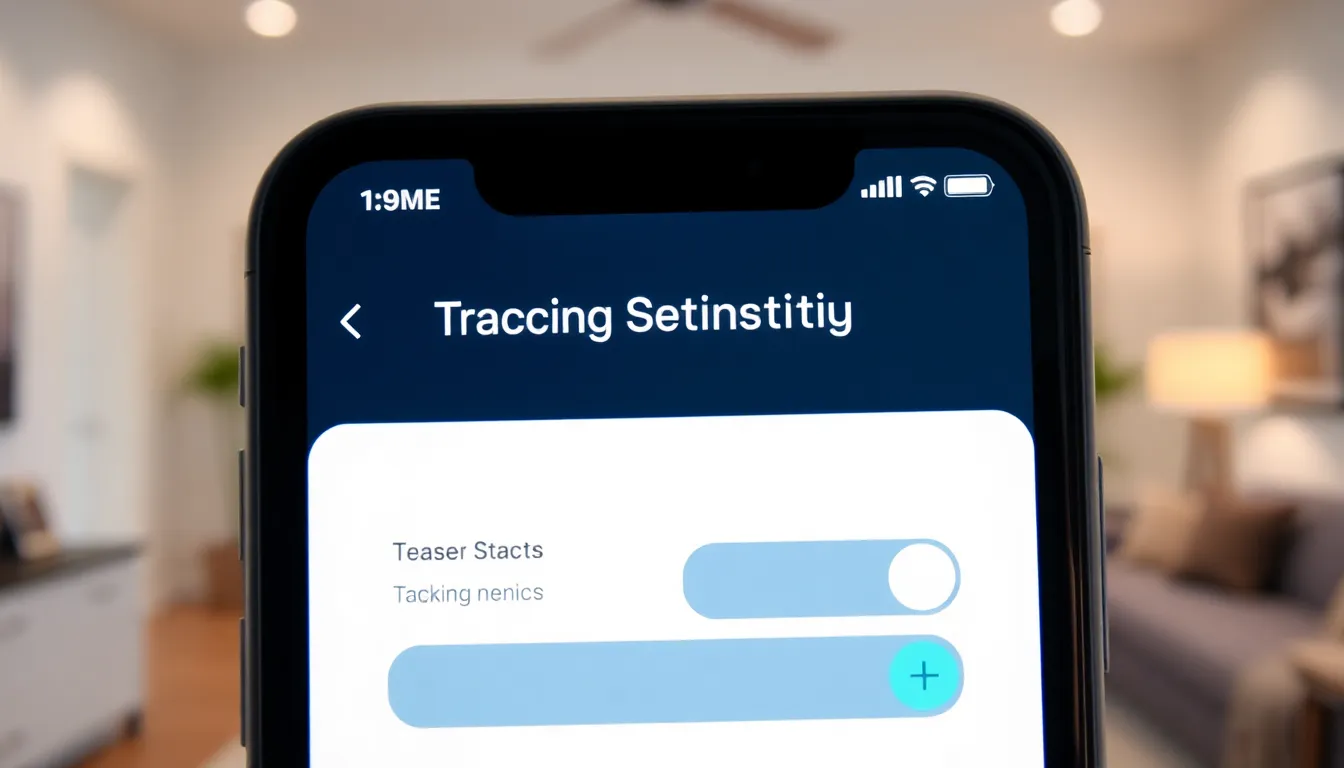In a world where privacy feels like a rare commodity, tracking sensitivity on the iPhone is your secret weapon. Imagine having the power to control how much of your digital footprints are visible to the prying eyes of apps and advertisers. Sounds like a superhero ability, right?
Tracking sensitivity isn’t just a fancy term Apple threw into their settings; it’s a game changer. It lets users dial up or down the level of data sharing, ensuring that their personal information stays close to the vest. Whether you’re a casual user or a privacy enthusiast, understanding this feature can help you navigate the digital landscape without feeling like you’re walking through a minefield. So, let’s dive into what tracking sensitivity really is and why it matters more than ever.
Table of Contents
ToggleWhat Is Tracking Sensitivity iPhone
Tracking sensitivity on the iPhone refers to a feature that gives users greater control over how their data is shared with apps and advertisers. This tool plays a crucial role in enhancing privacy, ensuring that user activity and preferences remain private. By adjusting tracking sensitivity settings, individuals can limit how much information apps collect regarding their behavior across different platforms.
Users encounter a straightforward interface to manage these settings in the iPhone’s privacy section. Options include allowing or denying tracking for specific apps, creating a tailored experience based on personal comfort levels. When tracking is disabled, apps cannot follow user activity, reinforcing privacy and limiting targeted advertisements.
Adopting tracking sensitivity reflects a proactive approach to personal data management. It helps individuals safeguard sensitive information against unwanted scrutiny and data harvesting. Companies creating apps are now required to request explicit permission before tracking, addressing user concerns about privacy invasion.
iPhone makes it easy for users to navigate these features. Navigation to Settings, then Privacy, offers clear directives on enabling and managing tracking sensitivity. Monitoring these settings regularly can further enhance digital safety.
In today’s environment, understanding tracking sensitivity is vital for both casual and serious users. Recognizing its implications fosters informed choices regarding personal information management. This feature is not merely an option; it represents a fundamental shift towards user empowerment in the digital space.
Understanding Tracking Sensitivity

Tracking sensitivity on the iPhone enables users to control their privacy online. It serves a critical function in managing how apps can access and use personal data.
Definition of Tracking Sensitivity
Tracking sensitivity refers to the settings on an iPhone that allow users to determine the extent to which their activity can be tracked by applications. It offers options to either permit or deny tracking requests from various apps. Users can adjust these preferences for individual apps, ensuring a tailored approach to digital privacy. Additionally, this feature prompts users to grant explicit permission before apps can follow their actions across platforms.
Importance in User Experience
Privacy remains a major concern for today’s digital users. Tracking sensitivity significantly enhances user experience by providing control over data privacy. When users manage their tracking settings, they can prevent unwanted advertising and minimize data collection, reducing digital clutter. This personalization creates a more secure environment tailored to individual preferences. Regularly managing tracking sensitivity settings promotes greater peace of mind, fostering trust in technology.
How to Adjust Tracking Sensitivity on iPhone
Adjusting tracking sensitivity on an iPhone is straightforward and enhances user privacy. Users can easily manage settings that control app tracking.
Steps to Change Settings
- Open the Settings app on the iPhone.
- Scroll down and select Privacy.
- Tap on Tracking.
- Toggle Allow Apps to Request to Track to enable or disable tracking requests.
- Review the list of individual apps and select those for which tracking will be allowed or denied.
Adjustments made through these steps ensure that users maintain control over what data they share with apps, reinforcing their privacy concerns.
Effects of Adjustments
Adjusting tracking sensitivity affects how apps interact with user data. When tracking is denied, apps cannot monitor activities across platforms. This limitation reduces the amount of personalized advertising experienced by users. Enhanced privacy fosters trust in using apps while navigating the internet. Individuals who frequently adjust these settings may notice a decrease in targeted advertisements, leading to a less intrusive online experience. By taking these steps, users actively shape their digital landscape.
Benefits of Managing Tracking Sensitivity
Managing tracking sensitivity offers several advantages that enhance user autonomy and privacy. Users gain control over their personal data by actively adjusting these settings. Applications cannot gather excessive information if tracking is disabled.
A secure digital environment emerges when users limit the data shared with apps. Regular reviews of tracking settings foster a heightened sense of confidence among users. Enhanced privacy not only protects individuals from unwanted scrutiny but also minimizes the number of targeted advertisements.
Increased awareness of tracking sensitivity cultivates smarter technology usage. Users benefit from customized experiences without sacrificing their privacy. They can specify which apps access tracking capabilities, allowing for tailored digital interactions.
The practice of managing tracking settings also aligns with broader trends toward digital rights. As companies must request explicit permission for tracking, user empowerment becomes paramount. Individuals assert control over their digital identities by adjusting tracking sensitivity, which strengthens their privacy stance.
Improved transparency results when users engage with tracking settings regularly. Adjusting these preferences also leads to a more enjoyable online experience. Users encounter fewer intrusive ads, creating a more pleasant digital landscape.
Maximizing the benefits of tracking sensitivity ultimately shapes a more secure and personalized online environment. This user-centric approach reflects a shift towards greater responsibility in data management. Empowerment in handling personal data transforms how individuals interact with technology, reinforcing trust and security.
Common Issues and Troubleshooting
Disabling tracking sensitivity features on an iPhone can lead to unforeseen issues. Some users might notice a decline in personalized experiences as apps have limited access to data. Apps may also fail to offer specific tailored content, which some users find frustrating.
Conflicts might arise between different app settings. For example, if an application doesn’t recognize tracking permissions, users may experience glitches or unexpected behaviors. Adjusting settings can resolve these conflicts, providing a more cohesive experience across applications.
Another common issue involves notifications related to tracking requests. Users often receive frequent prompts from apps seeking tracking permissions. If these notifications become overwhelming, users can imagine managing them through streamlined settings adjustments in the iPhone’s Privacy menu.
Battery performance can also be affected by tracking sensitivity settings. Some users report faster battery drainage when numerous apps attempt to track their activities. Monitoring app usage and selectively enabling tracking for essential applications can help maintain battery life.
Connecting to Wi-Fi networks can pose challenges when tracking sensitivity is enabled. Certain apps may fail to load content or connect properly if permissions aren’t set correctly. Users should ensure that each app has the appropriate tracking settings, especially when relying on data-heavy applications.
When troubleshooting issues, checking for software updates is crucial. Outdated versions of iOS can lead to compatibility problems with tracking sensitivity features. Keeping the iPhone updated can avoid many potential issues, ensuring that tracking settings function as intended.
By regularly reviewing tracking settings and addressing any issues, users can enhance their overall experience. Engaging with these settings creates a more secure environment tailored to personal preferences while promoting user autonomy in data management.
Tracking sensitivity on the iPhone is a vital tool for users seeking to protect their privacy in today’s digital landscape. By managing these settings, individuals can control how their data is collected and shared, fostering a more secure online experience. This feature not only enhances user autonomy but also aligns with the growing emphasis on digital rights and personal data management.
Regularly reviewing tracking settings empowers users to navigate their digital interactions with confidence. As they adjust these preferences, they can enjoy a tailored experience while minimizing unwanted advertising. Ultimately, embracing tracking sensitivity represents a proactive step towards safeguarding personal information and reinforcing trust in technology.




